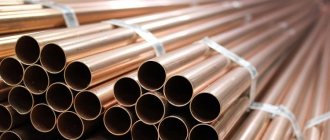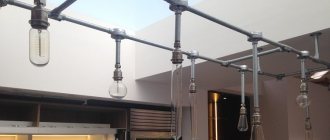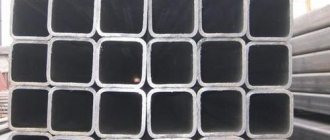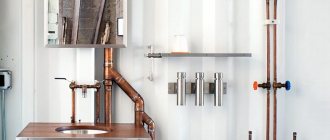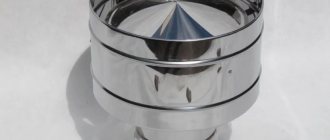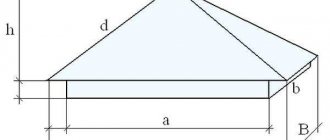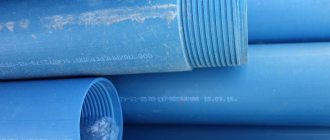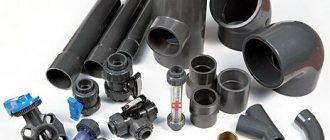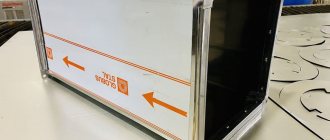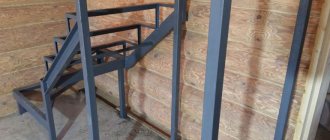When designating products, for example, a copper pipe with a diameter of 8 mm, we mean one of the main parameters of pipes - the outer diameter. Many properties of the future pipeline (working pressure, length, etc.) depend on this indicator. It is necessary to be able to operate with quantities such as inches and millimeters, since according to GOST, they are the main measures of this parameter. The digital equivalent of the values of parameters such as length and diameter is often used in formulas for various calculations.
Today, we can distinguish the following diameters of copper pipes, which, one way or another, appear in the tables:
- External;
- Interior;
- Nominal.
The very need for comparative tables with diameters arose due to different standards in Russia and Europe (All products related to copper pipes:). Since most pipe manufacturers are foreign, the characteristics use inches, while in our territory they operate with mm values, see.
| Ø, inch | Outer diameter + wall thickness, mm |
| 1/4 | 6.35+0.76 |
| 3/8 | 9.52+0.81 |
| 1/2 | 12.7+0.81 |
| 5/8 | 15.9+0.90 |
| 3/4 | 19.05+0.89 |
| 7/8 | 22.23+1.14 |
| 1 | 25.4+1.14 |
| 1 1/8 | 28.58+1.27 |
| 1 3/8 | 34.93+1.40 |
| 1 5/8 | 41.27+1.53 |
| 2 1/8 | 53.98+1.78 |
| 2 5/8 | 66.68+2.03 |
| 3 1/8 | 79.39+2.30 |
| 3 5/8 | 92.08+2.54 |
| 4 1/8 | 104.74+2.80 |
Table of steel pipe sizes - what is the diameter of such pipes
According to one of the dimensional characteristics, steel pipes differ in diameter, that is, cross-section. Classifying them according to this indicator and wall thickness allows you to create projects and calculations for transporting any liquid through pipelines. In this article we will try to figure out what diameters and sizes of metal pipes can be found.
Standard pipe diameters and measurement systems
The use of standard pipe sections when creating various types of pipelines greatly simplifies the development of the projects themselves by specialists.
Before you figure out what the main pipe sizes are and in what systems they can be used, you should take a closer look at the leading dimensional characteristics.
It is worth noting that the pipe diameters are determined specifically based on the above parameters in accordance with technical specifications and state standards.
These values are extremely important, because for a certain pipe diameter according to GOST you can find out about the corresponding thickness of their walls.
Diameter classification
Let's consider the types of diameters of steel pipes:
- Conditional (Du, Dy) - is the internal diameter of the pipe (mm), or a rounded value (in inches).
- Nominal (Dn, Dn).
- External diameter. The determination, as a rule, is carried out according to this parameter: 5-102 mm – pipes of small cross-section; 102-426 mm – medium-section pipes; 426 mm and more – large cross-section pipes.
- Inner diameter is also considered an important parameter that also applies to connecting fittings.
In addition to the huge number of steel pipes on offer that can be found on sale, pipes made from various types of plastic are currently used in almost all areas of construction. In this regard, regulatory documentation was prepared, among which there is a table with the diameters of steel pipes and their correspondence to analogues made of polymers.
Thanks to such tables, you can select the right pipe with great accuracy during the design of any transport system.
Measuring systems
The correspondence of the diameters of pipes of various types in both units of measurement can be found in the corresponding table.
When creating water and gas supply systems, steel pipes are currently still widely used. The cross-section of such pipes is measured in inches, for example: 2.4″ or 4″, or in fractions: 1 2/3 or 5/8″. In the process of assembling a pipeline whose pipe cross-section is marked in inches, you will not have any difficulties.
However, if there is a need to change or install combined systems (steel with copper or plastic pipes), a table of steel pipe sizes, that is, their sections, will be the best help for a specialist to correctly determine the required parameters. These standards contain the metric values of steel pipes and the corresponding cross-sections of plastic pipes.
According to standards adopted in the vast majority of countries, the internal diameter of pipes is measured in millimeters. At the same time, marking pipes in inches is widespread, which is considered to be equal to 2.54 cm.
Installation of a water supply system for residential buildings often involves the use of steel pipes with an internal cross-section of 15, 20 or 32 mm.
Large-section pipes made of steel and cast iron (non-pressure), used for the construction of sewerage systems, have a cross-section equal to 50/100 mm.
The importance of selecting the correct diameter of pipes to be laid
Thanks to the exact nominal diameter of the pipe for installing the water supply system, you can find out the amount of water transported
For everyday purposes, being aware of all the nuances associated with the applicability of pipe diameters in certain situations is very important.
For example, if there is a need to carry out maintenance on the heating system of a private house, the cross-section of the pipes is determined so that in winter the heating of the entire territory is the same.
The dimensions of steel, aluminum-plastic and PP pipes can be easily calculated without anyone’s help, and without even using correspondence tables.
To determine the cross-section of a pipe for use in heating systems, you can use the formula, which is deciphered as described below.
- D – internal section of the selected pipes;
- Q – heat flow, expressed in kilowatts;
- V – coolant velocity, m/s;
- DT is the temperature difference at both ends of the system, measured in ℃;
- sqrt – square root.
The table of metal pipe sizes is very important when calculating the cross-section of steel pipes. This way you will be able to clearly optimize your work, no unforeseen nuances will arise in the process, and you will be confident in the success of its implementation. In addition, you will spend your money wisely and save a lot of working time.
Inch volume value
The cross section of the pipe, expressed in inches, is easy to decipher. Diameter is most often measured in inches. 3.35 centimeters corresponds to one unit. The decoding of the indicator is different because the product is measured by the diameter inside the pipe, and not outside.
For example, for a one-inch workpiece, the internal diameter varies from 2.55 to 2.71 centimeters. The thickness of the walls affects its size.
A one-inch pipe has an outside diameter of 25.4 millimeters, and a two-inch pipe has a diameter of 50 millimeters. What then do the numbers 33.249 or 66498 mean?
Threads on inch pipes are made on the outer volume. Thus, the internal volume and thread diameter are related conventionally. Therefore, the size of pipe products is calculated by adding the numbers 25.4 or 50 and two wall thicknesses of the product.
Reference! To correctly convert one value to another, measurements are taken from the inside. Because, based on external measurement data, the result will be incorrect and the installation will be performed incorrectly, since the pipes have different wall thicknesses.
It should be borne in mind that each manufacturer focuses on its own pipe manufacturing standards.
If difficulties arise in decoding, you should seek the help of professionals who will help you choose the necessary products.
What is needed for soldering copper pipes
Soldering copper pipes, which is not difficult to do with your own hands, does not require expensive equipment or any special materials. In order to carry it out correctly, you will need the following equipment.
A burner that will heat the solder and the section of pipes where they will be connected. Such a burner is usually supplied with propane gas, the pressure of which is regulated using a welding reducer. Special device for cutting copper pipes. Since products made from this metal are very soft, they should be cut gently enough so as not to crush the walls. The modern market offers pipe cutters of various models, differing in both their functionality and technical capabilities.
The design of individual models of such devices, which is important, allows them to be used even for working in hard-to-reach places. A pipe expander is a device that allows you to expand the diameter of a copper pipe, which is necessary in order to perform soldering better. Various systems mounted from copper pipes use elements of the same cross-section, and in order to connect them efficiently, it is necessary to slightly increase the diameter of one of the elements being connected. This is precisely the problem that a device such as a pipe expander solves.
This is precisely the problem that a device such as a pipe expander solves.
Copper pipe flaring kit
A device for chamfering the ends of copper pipes. After trimming, burrs remain on the ends of the parts, which can interfere with obtaining a high-quality and reliable connection. To remove them and give the ends of the pipes the required configuration, a bevel remover is used before soldering. There are two main types of chamfering devices on the market today: those placed in a round body and those made in the form of a pencil. More convenient to use, but also more expensive, are round devices that can process soft copper pipes with a diameter of no more than 36 mm. To properly prepare copper pipes for soldering, it is necessary to remove all contaminants and oxides from their surface. For these purposes, brushes and brushes are used, the bristles of which are made of steel wire. Typically, brazing of copper pipes is performed with hard solder, which can be high- or low-temperature. High-temperature solder is copper wire containing about 6% phosphorus. Such wire melts at a temperature of 700 degrees, while for its low-temperature type (tin wire) 350 degrees is sufficient. The technology for soldering copper pipes involves the use of special fluxes and pastes that perform a protective function. Such fluxes not only protect the seam being formed from the formation of air bubbles in it, but also significantly improve the adhesion of the solder to the pipe material.
In addition to flux, solder and other basic elements, to solder copper pipes you will also need additional tools, which can be found in every workshop or garage. To solder or cook copper products, additionally prepare:
- regular marker;
- roulette;
- building level;
- a small brush with stiff bristles;
- hammer.
Before starting work, it is also important to decide how to solder copper pipes. There can be two main options: soldering copper with hard solder (used less frequently) and using soft solder. When addressing this issue, it is important to proceed from the fact that there are requirements for the use of one or another type of solder
Thus, hard solders are used for soldering elements of refrigeration units and air conditioners. In all other cases (water supply systems, heating systems, etc.) tin wire can be used. But no matter what technology is chosen, it should be remembered that flux is necessary in any case
When addressing this issue, it is important to assume that there are requirements for the use of one or another type of solder. Thus, hard solders are used for soldering elements of refrigeration units and air conditioners
In all other cases (water supply systems, heating systems, etc.) tin wire can be used. But no matter what technology is chosen, it should be remembered that flux is necessary in any case.
Cleaners for cleaning the inner surface of a copper pipe before soldering
Advantages and disadvantages
Copper pipes after heat treatment acquire additional useful qualities:
- Ability to withstand high pressure. Especially thick-walled pipes have this quality.
- Resistant to humid environments and sudden temperature changes. The operating range is from -100°C to 250°C.
- Resistance to UV rays, alkalis, acids and other various aggressive substances due to the use of a special inert composition during annealing.
- Increased flexibility.
- Easy installation.
- Service life more than 50 years.
- Antibacterial properties, so dangerous microorganisms do not appear, much less multiply, in products.
- Corrosion resistance.
- Smooth inner surface for good maneuverability.
- Resistance to deformation when exposed to high temperatures. Even for thin-walled pipes.
- Reduced heat loss and absence of condensation on the surface of rolled pipes with a polymer coating.
- Preservation of properties when water freezes in rolled pipes.
The main disadvantage of copper products is their high cost compared to other materials - polyvinyl chloride and steel. The cost of purchasing pipes pays off during their operation, because there is no need to carry out repair work and maintenance for a long time.
The disadvantages also include some difficulties during soldering. Only an experienced person who owns special tools and equipment can perform the work efficiently.
Unannealed copper pipe.
Negative aspects also include the weak resistance of rolled products with thin walls to mechanical stress. It is easily deformed.
The disadvantage is the high thermal conductivity of copper. Therefore, a heated pipe can easily cause injury in the form of a burn. It is recommended to use protective equipment during installation work and during system maintenance.
Metal water pipes
Metal pipes have been used for decades. Despite the emergence of new materials, they still have not lost their relevance. Metal, like plastic, has its pros and cons.
The biggest advantage of metal water pipes is mechanical strength. However, its service life is only a few years. In addition, complex installation and welding work increases installation and maintenance costs.
Steel
Steel pipes are made both from ordinary carbon steel and galvanized. Installation of a water supply system from steel components is carried out using adapters, tees and couplings that connect the pipes into a single system.
Welded and seamless steel pipes can withstand enormous loads, high pressure and sudden temperature changes.
Which pipes to choose for water supply (video)
The disadvantages of such water pipes include heavy weight, complex installation and corrosion. However, modern manufacturers have learned to coat the inner surface with a non-metallic layer, which increases the service life of the product and avoids corrosion.
Stainless steel products are superior to conventional ones in all main characteristics, but their cost differs significantly, which leads to a significant increase in the cost of the entire water supply system.
Copper
The throughput of copper water supply is higher than that of others. This is achieved due to a smoother internal surface, so smaller diameter pipes can be used. Copper has disinfectant properties, due to which copper pipes are widely used for drinking water supply systems.
The undoubted advantages of copper products include their presentable appearance, resistance to corrosion and long service life, which can reach 70-100 years.
However, the high cost of copper pipes and installation work is not affordable for everyone. Such water pipes are usually found in luxury homes, where luxury is considered one of the important indicators.
Comparison of alternative programs:
| Home Sweet Home | MyVirtualHome | Home Design Software – Home Design Software | Sketchup | |
| Description | Download Home Sweet Home, version 1.0 | Design your home | 3D interior design application | Download Sketchup, version Pro 8.0.3161 |
| Rating | ||||
| Downloads | 105 | 5 | 60 | |
| Price | $ 19.95 | $ 0 | $ 17 | $ 590 |
| file size | 18.53 MB | 11.00 MB | 11.48 MB | 104141 KB |
| Download | Download | Download | Download |
Tools and materials for copper soldering
- pipe cutter;
- chamfer;
- pipe expander;
- metal wool;
- vice;
- pliers;
- tweezers;
- soldering iron;
- solder;
- flux;
- borax;
- soldering oil;
- gas-burner.
Electric welding machine diagram.
A pipe cutter is required to cut pipes to length. The principle of operation of pipe cutters is the same, although you can find a lot of models on sale. The pipe for cutting it is clamped between the rollers and the blade, then the pipe cutter is rotated around, tightening the bottom bolt by a third of a turn. To get a smooth edge, the pipe is held strictly perpendicular to the tool. The pipe is usually cut in 5-6 turns. It is possible to perform low-temperature soldering of copper with a gas torch, since its temperature does not exceed 450°. Not all commercially available torch designs are suitable for soldering.
Before choosing a burner for soldering copper, you need to pay attention to the instructions, since those burners whose use begins with lighting a barbecue are not suitable for these purposes. How to solder copper correctly? You need to do this with a soldering iron or a torch with a narrow flame. Such a burner will heat the pipe in a matter of seconds, and the gas can will last for a long time if used sparingly.
When choosing a burner, you need to look at the composition of the gas in the cylinder. As a rule, it is a mixture of propane and butane, but the higher the butane content, the higher the flame temperature
Such a burner will heat the pipe in a matter of seconds, and the gas can will last for a long time if used sparingly. When choosing a burner, you need to look at the composition of the gas in the cylinder. Typically, it is a mixture of propane and butane, but the higher the butane content, the higher the flame temperature.
Metal wool is used to clean copper before using a torch and soldering iron. The end of the pipe or wire is tightly pressed with it and several rotational movements are made with force. This is enough for the wire, but the pipe should also be cleaned from the inside. Narrow tubes (fittings) can be cleaned with special brushes designed for this purpose, but the use of sandpaper, especially coarse sandpaper, and especially a file, is strictly prohibited. Copper is a soft metal and if you use sandpaper, the components of the sandpaper will remain on the surface, preventing adhesion and a good connection.
Copper spot welding diagram.
Solder can be purchased wound into spools for ease of use. This is tin wire, the diameter of which is about 3 mm
It is advisable to pay attention to the absence of lead in the solder, which should be indicated by a special inscription on the reel. An important component for soldering is flux, which wets the base metal (in this case copper) before soldering, penetrating into all capillaries. Flux spreads over the surface under the action of capillary forces
Before soldering properly, the surface must be completely clean and free of oxides. The weld will only be strong if the components are protected from the oxygen present in the air. The use of flux increases solder adhesion along with mechanical cleaning of surfaces
Flux spreads over the surface under the action of capillary forces. Before soldering properly, the surface must be completely clean and free of oxides. The weld will only be strong if the components are protected from the oxygen present in the air. The use of flux increases solder adhesion along with mechanical cleaning of surfaces.
When using flux, it does not matter much whether it is intended for lead-containing or lead-free solder; these varieties are interchangeable. Stainless steel soldering fluxes are not suitable for use with copper. Ordinary rosin can also be used, but there may be problems with its application.
Steel pipe diameters: size table
One of the main dimensional characteristics of metal pipes is their diameter.
Their classification according to this parameter, as well as wall thickness, makes it possible to carry out design calculations for transporting a particular type of substance through a pipeline.
Main parameters of steel pipe
Standard diameters and measuring systems for pipes
These can be the diameters of steel pipes
Standard diameters of steel pipes greatly facilitate the work of designers when choosing a particular type of pipeline for assembly.
Before we talk about what the pipe diameters are and what type of pipeline system they can be used for, we need to consider their main dimensional characteristics.
Pipe diameters are determined by TU and GOST based on these parameters.
These are the most important values, because for each specific pipe diameter, GOST determines the corresponding thickness of their walls.
About the types of pipe diameters
So, what are the diameters of steel pipes?
- Nominal diameter (DN, Dy) is the nominal size (in millimeters) of the internal diameter of the pipe or its rounded value, in inches.
- Nominal diameter of pipes (Dn,).
- Outer diameter of steel pipes. They are classified precisely according to this criterion: small sizes - from 5 mm to 102, medium sizes - from 102 mm to 426, large sizes - 426 mm and more.
- Pipe wall thickness is an important related parameter.
- The internal diameter of steel pipes is also their main dimensional characteristic. This also applies to connecting elements - system fittings.
Along with a wide range of metal analogues, pipes made from various types of plastic are now used in almost all areas of construction. As a result, regulatory documents were developed, for example, a table of the diameters of steel pipes and their compliance with polymer pipes.
They make it possible to accurately select pipes when designing a particular transport network.
Measuring systems
Nominal diameter (Dy) of the pipe, in mm
The diameter of its thread (G), in inches
Outer diameter (Dh), pipes, mm
Steel seam pipe, water and gas supply
Seamless steel pipe
The table shows the dimensions of different types of pipes, in millimeters and inches.
Steel pipes are still actively used in gas and water supply. The diameter of steel pipes is calculated in inches, for example - 1″ or 2″, or their fractions - 1/2 or 3/4″. When assembling a pipeline whose pipe diameters are defined in inches, you will not have any difficulties.
However, when there is a need to change or install combined systems, for example, steel pipes + plastic or copper analogues, then, in order to correctly select the parameters, the table of steel pipe diameters will be an indispensable assistant for a specialist.
This document defines the exact metric dimensions of steel pipes and their correspondence to plastic ones.
In accordance with the standard series adopted in most countries of the world, pipes have an internal diameter calculated in millimeters:
A system for measuring pipe diameters in inches is also used. 1 inch is approximately equal to 2.54 cm.
When assembling a transport system for residential buildings consisting of steel pipes, as a rule, pipes with an internal diameter of 15 mm, 20 mm or 32 mm are taken.
Large-diameter steel pipes used in sewer systems, as well as cast-iron non-pressure counterparts, have a diameter of 50/100 mm.
Why do you need to know exactly the diameter of the pipes being laid?
The exact diameter of a steel water pipe makes it possible to calculate the volume of substance transported through the system
For everyday use, knowledge of all the features of the pipe diameters used is especially important
For example, if you need to repair the heating system of your home, the diameter of the pipes must be calculated so that in winter the heating heats all living spaces evenly.
The size of steel, aluminum-plastic or polypropylene pipes can be easily calculated independently, without using the corresponding tables.
To find the diameter of pipes intended for heating, there is a formula: D = sqrt ((314∙Q)/ (V∙DT)), in which the symbols mean:
- D – internal diameter of the required pipes;
- Q is the heat flux measured in kW;
- V denotes the coolant speed, in meters per second;
- DT is the temperature difference at the inlet and outlet of the system, in degrees Celsius;
- sqrt – square root.
To calculate the diameters of steel pipes, a table is necessary to optimize your work. This way you will gain a lot of working time.
Messages 17
1 Topic from Ivan 2014-08-19 17:09:12
- Ivan
- Baccho Testis
- Inactive
- From: Russia
- With us from: 2014-01-20
- Messages: 25 294
Topic: Conversion table for copper pipe diameters from inches to millimeters
Standards for copper pipes are “as good as hell.” A plate with the most common standard sold in Russia. The topic will be edited a little later. Picture with average prices for mid-summer 2014. The forum doesn't sell pipes if anything
2015-01-01 22:08:54
- AdSense
2 Reply from transfi 2015-01-01 22:08:54
- transfi
- Professional
- Inactive
- From: Syktyvkar
- With us from: 2014-03-09
- Messages: 907
Re: Conversion table for copper pipe diameters from inches to millimeters
In the process of collecting materials for the construction of the RK, a question arose.
There is a copper pipe marked 42x1.5. As I understand it, these are metric sizes. But the question is, is it possible to use a tee for such a pipe, with an inch marking of 1 5/8″? Does the inch tee have enough clearance to accept metric pipe?
Has anyone encountered this? It's just that in my city, with copper fittings, everything is not simple
.
3 Reply from Ivan 2015-01-02 17:46:49
- Ivan
- Baccho Testis
- Inactive
- From: Russia
- With us from: 2014-01-20
- Messages: 25 294
Re: Conversion table for copper pipe diameters from inches to millimeters
In the process of collecting materials for the construction of the RK, a question arose.
There is a copper pipe marked 42x1.5. As I understand it, these are metric sizes. .
Hello.. measure the diameter of the pipe inside.
4 Reply from transfi 2015-01-02 17:58:54
- transfi
- Professional
- Inactive
- From: Syktyvkar
- With us from: 2014-03-09
- Messages: 907
Re: Conversion table for copper pipe diameters from inches to millimeters
Hello.. measure the diameter of the pipe inside.
The pipe is at work, I'll go and measure it tomorrow.
5 Reply from Ivan 2015-01-02 20:05:18
- Ivan
- Baccho Testis
- Inactive
- From: Russia
- With us from: 2014-01-20
- Messages: 25 294
Re: Conversion table for copper pipe diameters from inches to millimeters
Hello.. measure the diameter of the pipe inside.
The pipe is at work, I'll go and measure it tomorrow.
So grab the tee and measure it on the spot right away.
6 Reply from transfi 2015-01-02 20:36:24
- transfi
- Professional
- Inactive
- From: Syktyvkar
- With us from: 2014-03-09
- Messages: 907
Re: Conversion table for copper pipe diameters from inches to millimeters
There is no tee. Only inch sizes available. The pipe is three meters long, it is inconvenient to lead to the store (unless you cut off a piece). They seem to say that it fits easily, but I hesitate. Looks like I'll have to cut it.
7 Reply from Ivan 2015-01-03 10:30:46
- Ivan
- Baccho Testis
- Inactive
- From: Russia
- With us from: 2014-01-20
- Messages: 25 294
Re: Conversion table for copper pipe diameters from inches to millimeters
There is no tee. Only inch sizes available. The pipe is three meters long, it is inconvenient to lead to the store (unless you cut off a piece). They seem to say that it fits easily, but I hesitate. Looks like I'll have to cut it.
I measured an inch plumbing barrel... 33.25mm external thread along the ridge, which means the internal thread is a little smaller. If the tee on the outside is likely to fly through, then you must first measure the pipe from the inside. So, 1 5/8 should theoretically be suitable if the pipe is Chinese or Turkish, but if you count according to OST-266 (it seems to coincide with the German standard), it turns out 1 1/4 = 41.912 mm. Pipe . what standard is it for you? Most likely you need to buy an inch and a quarter and lightly remove the thread on the tee with a file... it depends on the pipe wall.
8 Reply from transfi 2015-01-03 10:49:20 (2015-01-03 15:13:45 edited by transfi)
- transfi
- Professional
- Inactive
- From: Syktyvkar
- With us from: 2014-03-09
- Messages: 907
Re: Conversion table for copper pipe diameters from inches to millimeters
Pipe – KIWA GASTEC QA 42X1.5. Now I’ll go for a walk with the child, and at the same time I’ll stop by work. I'll measure everything.
I haven't gotten to work yet. But now I thought that I misled you, Ivan, by inaccurately wording the question. The tee, I meant, is copper for soldering (for installing a remote reflux condenser). In my mind, I need 42x42x42, but in our refrigeration equipment stores they told me that all their copper pipes and fittings for it are in inch sizes. So I doubted whether my metric pipe would fit into their inch tee.
9 Reply from Ivan 2015-01-03 20:08:59
- Ivan
- Baccho Testis
- Inactive
- From: Russia
- With us from: 2014-01-20
- Messages: 25 294
Re: Conversion table for copper pipe diameters from inches to millimeters
So I doubted whether my metric pipe would fit into their inch tee.
So 42X1.5 is 1+1/4 inches, measure with a caliper if in doubt.
10 Reply from transfi 2015-01-03 21:15:50
- transfi
- Professional
- Inactive
- From: Syktyvkar
- With us from: 2014-03-09
- Messages: 907
Re: Conversion table for copper pipe diameters from inches to millimeters
Ivan, sorry, I can’t figure something out. You are talking about G1 1/4″ (according to OST-266), i.e. about the size of the pipe thread. I’m asking about the size of the copper pipe, or rather the tee to it. I look at the table in the first post. the closest value to my 42mm pipe is 1 5/8″, i.e. 41.27mm. There are such pipes and tees in the store, but this diameter is smaller than mine. Critical or not? Or am I asking something wrong?
11 Reply from Gennady 2015-01-03 21:23:10
- Gennady
- Distiller
- Inactive
- From: Volgograd
- With us from: 2014-11-11
- Messages: 525
Re: Conversion table for copper pipe diameters from inches to millimeters
Ivan, sorry, I can’t figure something out. You are talking about G1 1/4″ (according to OST-266), i.e. about the size of the pipe thread. I’m asking about the size of the copper pipe, or rather the tee to it. I look at the table in the first post. the closest value to my 42mm pipe is 1 5/8″, i.e. 41.27mm. There are such pipes and tees in the store, but this diameter is smaller than mine. Critical or not? Or am I asking something wrong?
It might be easier for you to buy a tee in a store and whatever else you need (you can measure it with a caliper), leave the receipt and try it at home, if it doesn’t work, take it in and take the money. I think it will be clearer this way
Fittings for connecting copper pipelines
Copper fittings are shaped elements by means of which individual sections of the pipeline are joined together. Copper pipe fittings are available in the following configurations:
- parallel couplings;
- tees;
- squares (45 and 90 degrees);
- crosses.
Types of copper fittings
The above copper fittings can be one-size - for connecting pipes of the same diameter, or transitional - for connecting sections of pipelines of different sizes.
Solder fittings
Connecting products intended for joining by soldering are called capillary. Their inner walls are covered with a thin layer of tin solder - the molten solder fills the gap between the walls of the connecting products and, after hardening, firmly adheres them to each other.
Among the high-quality products for soldering, we note Sanha fittings. This company produces copper fittings of all common sizes according to German quality standards from CW024A alloy. The connections are able to withstand pressure in the range of 16-40 Bar and an operating temperature of 110 degrees.
The technology for connecting copper pipelines using the soldering method is quite simple to implement:
- The mating surfaces of the pipe and fittings are cleaned of dirt, degreased and treated with fine-grained sandpaper.
- A layer of low-temperature flux up to 1 mm thick is applied to the pipe walls.
- The connecting elements are joined together, after which the joint is heated with a hot air gun or gas burner to a temperature of 400 for 10-15 seconds.
- Wait for the joint to cool down, after which the remaining flux is cleaned with a rag.
Scheme for soldering copper pipes
Soldering must be done in a ventilated area, since when solder and flux melt, gases harmful to the body are released.
Push-in connections
Collet fittings, also known as compression fittings for copper pipes, make a serviceable connection that must be dismantled. All collet fittings are classified into two groups:
- “A” – for products made of hard and semi-hard copper;
- “B” – for pipes made of soft copper.
They differ in that class “B” fittings have an internal sleeve - a fitting, onto which the connected sections of the pipeline are mounted. The fitting acts as a supporting element that prevents deformation of the copper walls during crimping.
Compression Copper Fitting
Connection installation technology:
- A union nut and a split ring are put on the pipe.
- The ring is placed at a distance of 1 cm from the cut.
- The pipe is pressed onto the fitting fitting.
- The union nut is tightened by hand until it stops, after which it is tightened using an adjustable or open-end wrench.
Press connection
Press fittings for copper pipes consist of a body, a fitting and a crimp sleeve. Their installation takes a minimum of time - the joining sections of the pipeline are inserted into the socket on the fitting, after which the sleeve is crimped using press pliers. This tool can be rented at a plumbing store or purchased, prices start at 3 thousand rubles.
Press fitting installation
This connection is maintenance-free; unlike a collet joint, you will not be able to dismantle it without compromising the integrity of the fitting. In case of leaks, it is necessary to replace the connecting element. Note that press fittings are the most reliable and durable, their service life reaches up to 30 years.
General properties and production methods
The characteristics of copper pipes are recorded in GOST standards. The products are resistant to corrosion, deformation, and ultraviolet radiation. The product is plastic, has high thermal conductivity, is resistant to vibration when installed in a water supply system, etc.
The properties of copper determined the absence of chemical reactions with working compositions (fats, oils). The products are not susceptible to bacteria, fungi, etc.
Chloride compounds do not deform copper products and impart strength and wear resistance to pipes. The internal surfaces of structures are not subject to the fixation of lime deposits and inorganic compounds. The products are operated at average temperatures of -200... +250°C, and are characterized by a small coefficient of expansion under thermal influence.
Copper products are produced by rolling and pressing methods. Depending on the purpose, final processing can be performed in an annealed or unannealed version.
Advantages of copper pipes over plastic ones
Plumbing copper pipe, despite the very long history of its existence, successfully competes with modern products - plastic and metal-plastic products for plumbing. In many respects it is noticeably superior to them:
- Copper is impermeable to foul-smelling, harmful substances and even oxygen.
- Copper pipes, unlike plastic ones, are not susceptible to the destructive effects of chlorine, which is contained in tap water. Plastic pipes that are more resistant to chlorine are supplied exclusively to the US market, where water is chlorinated similarly to Russia. Such products cost no less than copper ones. In Europe, the requirements for chlorine content are much lower, so plastic for low-chlorinated water that meets the European standard is common on the domestic market.
- Chlorine, being a strong oxidizing agent, promotes the formation of patina on the inner surface of a copper pipe - a durable, thin protective layer. Thanks to this, the service life of the pipeline is significantly extended.
- Resistant to ultraviolet radiation. Plastic evaporates when exposed to sunlight.
- Insignificant, lower than that of plastic pipes, roughness coefficient, which allows the use of copper products of smaller diameter under the same conditions. This is possible, including due to the absence of overgrowing of the walls with colonies of microorganisms and corrosion products.
- Copes much better with prolonged heat loads.
- According to research, plastic pipelines have the least reliable fittings and connections. For copper ones, on the contrary, these elements of the system are the most reliable.
- The quality of copper is almost stable and the same from different manufacturers, which is not typical for plastic products (there are many counterfeit products of dubious quality in the consumer market).
- It is characterized by antibacterial properties (pathogenic flora is suppressed). Plastic pipes release low-molecular organic matter; over time, the walls become overgrown with biofilm.
- It has a very long service life: it does not deteriorate, does not age, and retains its original strength. Copper pipes and fittings last as long as the building itself without replacement. Plastic products, with existing technologies, cannot yet occupy the niche of durable and high-quality pipelines.
Regulatory Requirements
As expected, all production and installation processes are strictly regulated by state standards.
Production
For the production of pipe fittings, copper alloys are used, the copper content of which is determined by Russian GOST 617-2006 (instead of GOST 617-90), R 52318-2005, 859–2001, 11383-75 and the European quality standard EN 1057, and, as a rule, never less than 99.5%. The following grades of copper are distinguished:
- M1. The copper content in combination with silver is 99.9%. The almost absolute purity of the alloy provides the best indicators of ductility, strength, thermal and electrical conductivity of the material. Brand M1 is recommended for heating circuits (max t working environment - 250⁰С), as well as cryogenic installations.
- M2. Copper and silver content – 99.7%.
- M3. - so-called technical copper, made as a result of secondary smelting or fire and electrolytic refining. Copper and silver content – 99.5%. Rolled metal of the M3 grade is characterized by good strength and affordable cost.
A decrease in the proportion of copper and an increase in the proportion of alloyed elements (nickel, tin, iron, lead, arsenic, etc.) primarily affect the electrical conductivity coefficient, significantly reducing it. The strength index remains practically unchanged.
Quality control standards are determined by GOST 24231-80 and 6507-90.
In addition to the chemical composition, the standards stipulate a number of technical conditions in accordance with which copper pipe fittings are produced:
- No delamination, cracks, rust or burrs on the ends.
- The inner surface of the pipes must be smooth and free of bulges that would impede the flow of the carrier. The permissible number of recesses and their size are strictly limited: no more than 2 per linear meter and up to 0.25 mm, respectively.
- Diameters correspond to established standard sizes.
- Support of each batch (coil) with technical documentation and labeling.
The marking is deciphered as follows:
- Manufacturing technology:
- D – Cold-deformed rolled.
- G – Pressed.
- Cross section shape:
- KR (K) – Round.
- PP – Rectangular.
- PC – Square.
- PO – Oval.
- Production accuracy:
- P – increased accuracy.
- N – within the normal range.
- K – accuracy of wall thickness.
- And – reference diameter accuracy.
- B – length accuracy.
- O – curvature accuracy.
- P – standard for stretching.
- N - Vickers hardness.
- Type of plasticity:
- M/L – soft.
- P/F – semi-solid.
- T/H – hard.
- Length designations:
- ND – non-gauge pipeline.
- MD/KD – measuring pipeline.
- BT - bay.
- Coil winding shape designation:
- BU - ordered.
- BS – spiral.
An example of decoding the markings is shown in the photo below:
Installation
Installation and operation standards are set out in SP 40-108-2004:
- The connection of copper communications with pipelines made of steel and aluminum is carried out in a strictly defined sequence: in front of the copper sections in the direction of movement of the carrier. Failure to comply with this principle leads to the effect of electrochemical corrosion. There are no special restrictions regarding brass and plastic pipes.
- The maximum permissible speed of the carrier in the circuit is 2 m/s.
- The water hardness index should be in the range from 1.42 to 3.1 mEq/l. Other indicators deplete copper resources.
Important! Special requirements are imposed on the degree of purification of the transported liquid. The presence of solid particles in the composition reduces the service life of the pipeline, because soft metal wears out under their influence. To prevent this problem, a mechanical cleaning filter is installed at the inlet.
Types of copper pipes
Such products vary in size and cross-section and come in the following types:
- Annealed copper pipe. To acquire softness, such products are subjected to heat treatment. This simplifies their installation.
- Unannealed copper pipes. These are straight sections from 1 to 5 m long.
The cross-section of the pipes can be classic or rectangular. The latter are used in creating conductors for stator windings, which are cooled by liquids. Their production is complex and the cost is higher than ordinary ones. The most popular diameter of copper pipes for water supply is from 10 to 23 mm, for drainage systems - from 30 to 45 mm.
How to calculate the diameter of a polymer and metal-polymer pipe
In some cases, the question arises - how to determine the diameter of a pipe made of metal-plastic or PVC? For these samples, the important size is the internal diameter; it is considered the determining value in system calculations. Since our own fittings are produced for all these types, there can be no discrepancy, hence the priority of throughput.
Parameters are important when designing any system, domestic or industrial. Discrepancies in values can cause serious errors in calculations, which will lead to poor performance or accidents
Therefore, it is important to have accurate diameter and capacity data.
Measurements in inches and millimeters, their ratio
Products are produced using a certain standard, and the pressure does not change. It is necessary to know the exact correspondence of pipe diameters having different units of measurement. If you neglect this data, then it is impossible to determine suitable pipes.
To select a size, use data from the table, and to replace an element, use a very approximate value. There are no exact correspondences between measurements, so pipe products are more accurately selected in a practical way.
Correspondence table used in practice:
| Diameter in millimeters | Diameter in inches |
| 15 mm | ½ inch |
| 20 mm | ¾ inch |
| 25 mm | 1 inch |
| 50 mm | 2 inches |
| 80 mm | 3 inches |
| 100 mm | 4 inches |
| 150 mm | 6 inches |
According to the table, identical products expressed in different units of measurement are determined.
Measurement in inches. The diameter value in inches is indicated by a number with a double prime, for example, 3”, or as a fraction ¼.
What volumes of standard pipes do inch products correspond to:
1.standard pipe size is 12 inches, translated 300 mm.
2.The size of 3 inches corresponds to 80 mm.
- The product's translation means 200 inches.
- Millimeters converted to inches are 1¼.
5. rolled pipe equal to 40 millimeters is displayed in inches as 1 ½.
6. a pipe of 15 millimeters in inches is indicated as ½.
A 7.4-inch diameter in metric is 100 mm.
8. rolled pipe equal to 3/4 inch is converted to 20 mm.
9. rolled pipe equal to 1/2 inch in metric is equal to the number 15.
Inch and millimeter sizes of products are constantly used in practice; in order to assemble a pipeline efficiently and quickly, you need to be able to understand the tables of the correlation of these parameters. They help to select pipes of the same size, even if they are expressed differently.
Article rating:
Save to:
Dimensions of copper pipes in inches and millimeters Link to main publication
Installation of copper heating pipes
The most reliable and popular method of installing copper heating pipes is soldering. Step-by-step instructions for performing the work:
- Cut a piece of the product to the required length.
- Cut a chamfer along the inner diameter.
- Clean the outside of the pipe and the inside of the connecting element (fitting). To do this you need to use a synthetic brush.
- To create a reliable connection, it is necessary to cover the treated surfaces with a layer of flux.
- Light the gas burner and slowly heat the parts to be joined.
- Heat the surfaces until the flux melts.
- When the flux becomes liquid, take soft solder, which is sold in rods, and place it in the place where the seam should be made.
- Gradually the wire will melt and begin to spread along the joint, filling the free space.
Wait until the seam is formed throughout the joint without voids, wait for the finished joint to cool.
Process steps
Let's consider the process step by step for different connection options.
Low temperature soldering connection
Experts say that for such work you need to purchase low-melting solder and low-temperature flux. The gas burner can be filled with a mixture that includes propane, air or butane.
The flame must be directed strictly along the pipe seam, moving across the entire joint area. This is done to ensure uniform heating of all areas. Do not forget to periodically coat the gap with solder, it will gradually begin to melt. As soon as melting begins, you need to remove the burner, and the substance will fill the capillary gap. When the gap is completely filled, the parts need to cool under normal conditions, without temperature changes. A connection that has not cooled down must not be touched.
Sometimes it is not recommended to solder any products; in such cases, preference is given to welding. The process is practically no different from soldering. But before you move on to the welding process, familiarize yourself with the safety rules and work flow. You will need safety glasses.
High temperature soldering
The composition of the gas burner filler is changing; now it is filled with propane with oxygen or acetylene with air. Warming up should not take much time, the device should produce a blue flame.
The flame, as in the case of low-temperature soldering, must be applied across the entire joint, changing the position of the burner. When the metal reaches approximately 750 degrees, it will turn a dark red color. At this moment you need to use solder, you can heat it with a burner. However, the solder should ideally be heated away from the part.
The product must be given a temperature at which the solder will quickly melt and fill the space between the parts. After complete filling, you need to leave the structure to cool.
Repair
You can fix problems with your plumbing or household appliances, such as a refrigerator or split system, with your own hands.
Metal delamination is a common problem. In this case, high-temperature soldering is used, this will significantly extend the service life of the system. A common occurrence is the appearance of cracks in pipe bends. Craftsmen recommend using low-temperature welding.
In repairs, it is also necessary to clean the surfaces before starting work, otherwise the structure will quickly fail. If the fitting leaks, you will have to cut out this part of the pipe and solder a new one with a new coupling. If a nut or gasket breaks, it is enough to replace only this part.
Safety precautions
Copper has a high thermal conductivity, so you must wear mittens or gloves on your hands, otherwise burns cannot be avoided. Elements should only be handled with tongs or protective gloves.
You need to apply flux carefully, making sure that it does not get on your body. Otherwise there will be a chemical burn
If you do get the substance on your hands, you need to leave the work and wash the area with plenty of soapy water.
Pay attention to the clothes you are going to wear to do the work. It should not be synthetic, because this material is highly flammable
It is better to choose clothes made from natural cotton.
Masters advise beginners to practice on pipe scraps before starting work. So, after a couple of workouts, the result will be much better.
